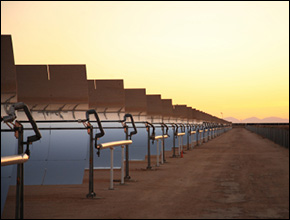Solar Power Plants Drain Desert Waters
 The push for low-carbon energy alternatives could further compromise already limited water resources in the Southwest United States.
The push for low-carbon energy alternatives could further compromise already limited water resources in the Southwest United States.
“When push comes to shove, water could become the real throttle on renewable energy,” said Michael E. Webber, assistant professor at the University of Texas at Austin, in The New York Times this week. Webber is a researcher and educator in UT Austin’s Department of Mechanical Engineering and also serves as Associate Director for the Center for International Energy and Environmental Policy.
One of the latest alternative energy fads includes 35 large-scale solar projects in California that would produce 12,000 megawatts of electricity— equivalent to 10 nuclear power plants. The California projects, however, represent only a handful of solar farm proposals that are cropping up in neighboring states as well.
In the sunny Amargosa Valley of Nevada, the German-owned company Solar Millennium is looking to buy water rights from area alfalfa farmers in an attempt to develop a 500-megawatt solar power plant complex. Companies like Solar Millennium offer a green solution for the on-coming energy crisis, and promise hundreds of jobs to combat the economic recession—but with the alarming water consumption of solar farms, many area residents are unwilling to ride this particular green wave.
Skeptics question the desert location—already in short supply of water— because the cooling process for this alternative energy scheme would require 1.3 billion gallons (4.9 billion liters) of water per year, or roughly 20 percent of the area’s water supply.
“I’m worried about my well and the wells of my neighbors,” said retired chemical engineer George Tucker to The New York Times.
The specific model proposed for the Amargosa Valley is a solar thermal power plant, which uses a system of mirrors to heat water into vapor. Photovoltaic power plants offer an alternative model that clusters a large group of solar panels, like those typically used on rooftops. While the thermal power model tends to be more efficient and less costly than the solar panel model, it uses significantly more water.
Some of the water used by solar thermal plants is re-used through a cycle of evaporation and condensation that propels a turbine and generates electricity—similar technology to the 18th century steam engine. However, this cycle also traditionally uses evaporative “wet” cooling, which requires a significant amount of water that cannot be recycled. Dry cooling uses less water by instead running a series of fans and heat exchangers. The dry method is more expensive, so “wet” cooling is preferred by industry.
“I don’t think it will be an obstacle to the development of solar energy, but we have to pay attention and deploy solar technologies that use appropriate amounts of water,” said Kristin K. Mayes, Chairman of utility regulator Arizona Corporation Commission, to The Times.
The solar thermal farms proposed for the Amargosa Valley would employ the vapor-mirror system, as well as the wet cooling method — using 1.3 billion gallons (4.9 billion liters) of water per year. The Times reported that a dry-cooled project in southern California would “consume an estimated 25 million gallons of water a year,” while a wet-cooled steam plant half its size “would draw 705 million gallons.”
Currently it is illegal for power plants to use drinking-quality water for cooling processes in California, but a bill in the state’s congress could amend the law to make an exception for renewable power plants.

is a Traverse City-based assistant editor for Circle of Blue. She specializes in data visualization.
Interests: Latin America, Social Media, Science, Health, Indigenous Peoples









Comments are closed.